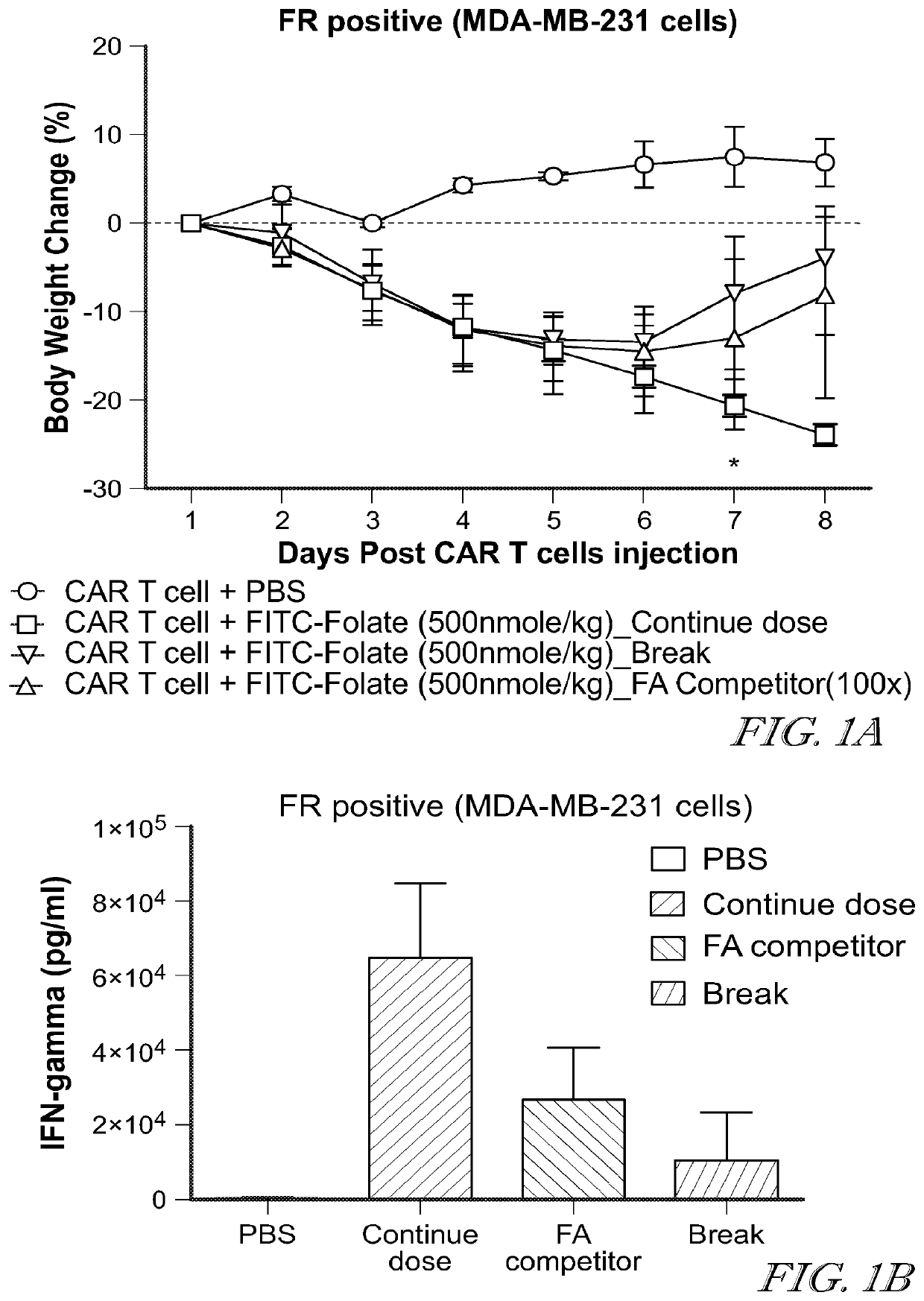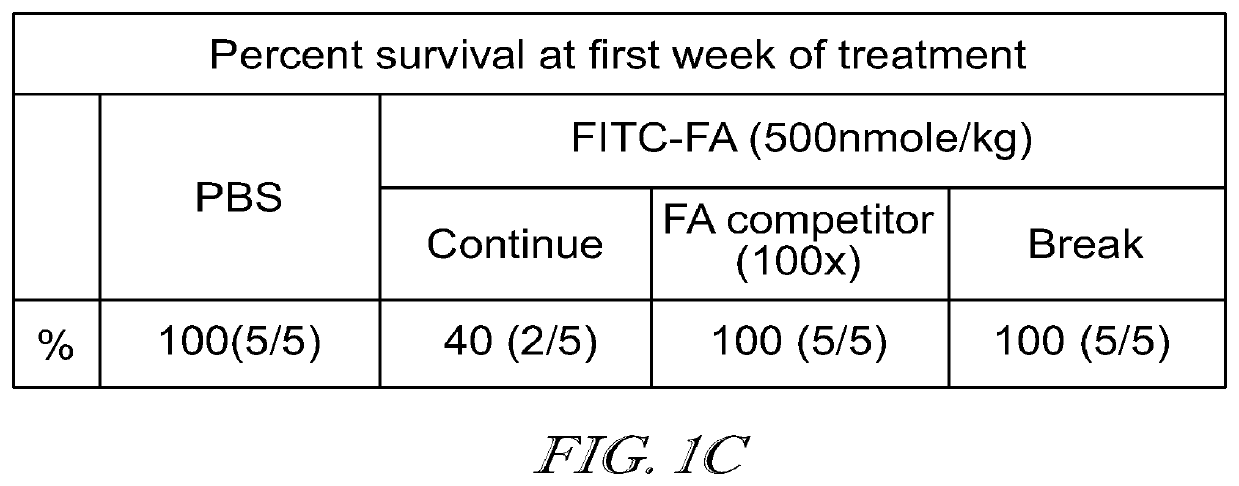Compositions and methods for car t cell therapy
a car t cell and cell therapy technology, applied in drug compositions, antibody medical ingredients, peptides, etc., can solve the problems of limited success in eliminating disease (e.g. cancer) in clinical trials, inability to prolong activation and expand the car t cell population in vivo, and inability to inhibit or prevent cytokine release syndrome in patients
- Summary
- Abstract
- Description
- Claims
- Application Information
AI Technical Summary
Benefits of technology
Problems solved by technology
Method used
Image
Examples
example 1
Synthesis of FITC-Folate
[1341]
[1342]Folate-γ-ethylenediamine was coupled to fluorescein isothiocyanate (FITC) isomer I (Sigma-Aldrich) in anhydrous dimethylsulfoxide (DMF) in the presence of tetramethylguanidine and diisopropylamine. The crude product was loaded onto an Xterra RP18 preparative HPLC column (Waters) and eluted with gradient conditions starting with 99% 5 mM sodium phosphate (mobile phase A, pH 7.4) and 1% acetonitrile (mobile phase B) and reaching 90% A and 10% B in 10 min at a flow rate of 20 mL / min. Under these conditions, the FITC-folate main peak typically eluted at 27-50 min. The quality of the FITC-folate fraction was monitored by analytical reverse-phase HPLC with a UV detector. Fractions with greater than 98.0% purity (LCMS) were lyophilized to obtain the final FITC-folate product. As known in the art, the compound with this structure is also referred to as EC17.
example 2
Synthesis of FITC-PEG12-Folate
[1343]
[1344]Universal polyethylene glycol (PEG) Nova Tag™ resin (0.2 g) was loaded into a peptide synthesis vessel and washed with isopropyl alcohol (i-PrOH) (3×10 mL) and dimethylformamide (DMF, 3×10 mL). 9-fluorenylmethoxycarbonyl (Fmoc) deprotection was carried out using 20% piperidine in DMF (3×10 mL). Kaiser tests were performed to assess reaction progress. To the vessel was then introduced a solution of Fmoc-L-glutamic acid 5-tert-butyl ester (Fmoc-Glu-(O-t-Bu)-OH) (23.5 mg) in DMF, N,N-diisopropylethylamine (i-Pr2NEt) (4 equiv), and benzotriazol-1-yl-oxytripyrrolidinophosphonium hexafluorophosphate (PyBOP) (2 equiv). Fmoc deprotection was carried out using 20% piperidine in DMF (3×10 mL). To the vessel was then introduced a solution of N10-TFA-Pte-OH (22.5 mg), DMF, i-Pr2NEt (4 equiv), and PyBOP (2 equiv). Argon was bubbled for 2 h, and the resin was washed with DMF (3×3 mL) and i-PrOH (3×3 mL). After swelling the resin in dichloromethane (DCM), ...
example 3
Synthesis of FITC-PEG20-Folate
[1345]
[1346]Ethylenediamine, polymer-bound (200-400 mesh)-resin (50 mg) was loaded into a peptide synthesis vessel and swollen with DCM (3 mL) followed by DMF (3 mL). To the vessel was then introduced the Fmoc-PEG20-COOH solution (131 mg, 1.0 equiv) in DMF, i-Pr2NEt (6.0 equiv), and PyBOP (4.0 equiv). Argon was bubbled for 6 h, the coupling solution was drained, and the resin was washed with DMF (3×10 mL) and i-PrOH (3×10 mL). Kaiser tests were performed to assess reaction progress. Fmoc deprotection was carried out using 20% piperidine in DMF (3×10 mL), before each amino acid coupling. The above sequence was repeated to complete the reaction with Fmoc-Glu-OtBu (72 mg, 2.0 equiv) and Tfa.Pteroic-acid (41 mg, 1.2 equiv) coupling steps. The resin was washed with 2% hydrazine in DMF 3×10 mL (5 min) to cleave the trifluoro-acetyl protecting group on pteroic acid and washed with i-PrOH (3×10 mL) followed by DMF (3×10 mL). The resin was dried under argon for ...
PUM
| Property | Measurement | Unit |
|---|---|---|
| compositions | aaaaa | aaaaa |
| body weight | aaaaa | aaaaa |
| hydrophilic | aaaaa | aaaaa |
Abstract
Description
Claims
Application Information
 Login to View More
Login to View More - R&D
- Intellectual Property
- Life Sciences
- Materials
- Tech Scout
- Unparalleled Data Quality
- Higher Quality Content
- 60% Fewer Hallucinations
Browse by: Latest US Patents, China's latest patents, Technical Efficacy Thesaurus, Application Domain, Technology Topic, Popular Technical Reports.
© 2025 PatSnap. All rights reserved.Legal|Privacy policy|Modern Slavery Act Transparency Statement|Sitemap|About US| Contact US: help@patsnap.com



